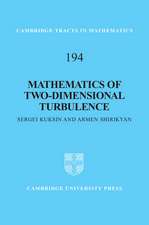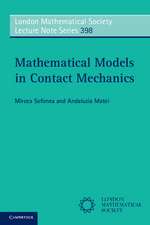Physics of Transitional Shear Flows: Instability and Laminar–Turbulent Transition in Incompressible Near-Wall Shear Layers: Fluid Mechanics and Its Applications, cartea 98
Autor Andrey V. Boiko, Alexander V. Dovgal, Genrih R. Grek, Victor V. Kozloven Limba Engleză Paperback – 27 noi 2013
To access the supplementary material go to extras.springer.com and type in the ISBN for this volume.
| Toate formatele și edițiile | Preț | Express |
|---|---|---|
| Paperback (1) | 640.55 lei 6-8 săpt. | |
| SPRINGER NETHERLANDS – 27 noi 2013 | 640.55 lei 6-8 săpt. | |
| Hardback (1) | 644.95 lei 6-8 săpt. | |
| SPRINGER NETHERLANDS – 15 sep 2011 | 644.95 lei 6-8 săpt. |
Din seria Fluid Mechanics and Its Applications
- 17%
 Preț: 462.79 lei
Preț: 462.79 lei - 18%
 Preț: 700.78 lei
Preț: 700.78 lei - 18%
 Preț: 1014.58 lei
Preț: 1014.58 lei - 17%
 Preț: 524.76 lei
Preț: 524.76 lei - 15%
 Preț: 646.30 lei
Preț: 646.30 lei - 18%
 Preț: 789.65 lei
Preț: 789.65 lei - 18%
 Preț: 780.82 lei
Preț: 780.82 lei - 20%
 Preț: 630.17 lei
Preț: 630.17 lei - 20%
 Preț: 696.89 lei
Preț: 696.89 lei - 18%
 Preț: 897.65 lei
Preț: 897.65 lei - 18%
 Preț: 1577.13 lei
Preț: 1577.13 lei - 15%
 Preț: 539.41 lei
Preț: 539.41 lei - 18%
 Preț: 1112.30 lei
Preț: 1112.30 lei - 18%
 Preț: 1116.89 lei
Preț: 1116.89 lei - 24%
 Preț: 1069.06 lei
Preț: 1069.06 lei -
 Preț: 443.31 lei
Preț: 443.31 lei - 15%
 Preț: 583.93 lei
Preț: 583.93 lei - 24%
 Preț: 1068.76 lei
Preț: 1068.76 lei - 24%
 Preț: 961.13 lei
Preț: 961.13 lei - 18%
 Preț: 835.15 lei
Preț: 835.15 lei - 18%
 Preț: 960.61 lei
Preț: 960.61 lei - 18%
 Preț: 949.55 lei
Preț: 949.55 lei - 18%
 Preț: 957.76 lei
Preț: 957.76 lei - 15%
 Preț: 590.27 lei
Preț: 590.27 lei - 15%
 Preț: 651.19 lei
Preț: 651.19 lei - 15%
 Preț: 646.62 lei
Preț: 646.62 lei - 15%
 Preț: 655.78 lei
Preț: 655.78 lei - 18%
 Preț: 1660.65 lei
Preț: 1660.65 lei - 18%
 Preț: 1087.54 lei
Preț: 1087.54 lei - 15%
 Preț: 644.30 lei
Preț: 644.30 lei - 24%
 Preț: 786.42 lei
Preț: 786.42 lei - 18%
 Preț: 1582.35 lei
Preț: 1582.35 lei - 18%
 Preț: 958.07 lei
Preț: 958.07 lei
Preț: 640.55 lei
Preț vechi: 753.60 lei
-15% Nou
Puncte Express: 961
Preț estimativ în valută:
122.57€ • 128.31$ • 101.42£
122.57€ • 128.31$ • 101.42£
Carte tipărită la comandă
Livrare economică 08-22 aprilie
Preluare comenzi: 021 569.72.76
Specificații
ISBN-13: 9789400737112
ISBN-10: 9400737114
Pagini: 300
Ilustrații: XXVIII, 272 p.
Dimensiuni: 155 x 235 x 16 mm
Greutate: 0.42 kg
Ediția:2012
Editura: SPRINGER NETHERLANDS
Colecția Springer
Seria Fluid Mechanics and Its Applications
Locul publicării:Dordrecht, Netherlands
ISBN-10: 9400737114
Pagini: 300
Ilustrații: XXVIII, 272 p.
Dimensiuni: 155 x 235 x 16 mm
Greutate: 0.42 kg
Ediția:2012
Editura: SPRINGER NETHERLANDS
Colecția Springer
Seria Fluid Mechanics and Its Applications
Locul publicării:Dordrecht, Netherlands
Public țintă
GraduateCuprins
Part I Fundamentals of the linear stability theory : 1 Concept of hydrodynamic stability.- 1.1 Hydrodynamic stability .- 1.2 Stability of fluid motion in time .- 1.2.1 Critical parameters for onset of instability .- 1.2.2 Conditional stability .- 1.2.3 Growth of disturbance energy .- References .- Further Reading .- 2 Theoretical aspects : 2.1 Formulation of linear hydrodynamic stability problems .- 2.1.1 Spectral formulation of stability .- 2.1.2 Inviscid instability mechanism .- 2.1.3 Viscous instability mechanism .- 2.2 Instability in space .- 2.3 Gaster’s transformation .- 2.4 Squire theorem .- 2.5 Adjoint problem and bi-orthogonality of normal modes .- 2.6 Completeness of solutions for the Orr–Sommerfeld and Squire equations.- References .- Further Reading .- Part II Generic problems : 3 Instability of plane parallel flows : 3.1 Plane Couette flow .- 3.2 Plane Poiseuille flow .- 3.2.1 Numerical results .- 3.2.2 Experimental linear stability investigations .- 3.3 Method of linear stability calculations .- Exercises.- References .- Further Reading .- 4 Instability of the flat-plate boundary layer : 4.1 Historical notes .- 4.2 Solution of the Orr–Sommerfeld equation for the boundary layers .- 4.3 Nonparallel flow effects .- 4.3.1 Outline of theoretical approaches to account for nonparallel effects .- 4.3.2 Modern view on the place and role of nonparallel effects in the Blasius boundary layer .- Exercises .- References .- Further Reading .- 5 Instabilities of plane flows over curvilinear surfaces: 5.1 Influence of curvature on the basic flow .- 5.1.1 Equations of motion in cylindrical coordinates .- 5.1.2 Description of the flow in boundary layers over curvilinear surfaces .- 5.2 Hydrodynamic instability at curvilinear surfaces .- 5.2.1 Taylor problem .- 5.2.2 Dean problem .- 5.2.3 G¨ortler problem .- Exercises .- References .- Further Reading .- 6 Some other basic factors of shear-layer stability: 6.1 Axial flowsymmetry .- 6.2 Two-dimensional geometry .- 6.3 Transverse flow periodicity .- 6.4 Pressure gradients .- 6.4.1 Streamwise pressure gradient .- 6.4.2 Transverse pressure gradient .- 6.5 Heat transfer .- 6.6 Fluid suction .- 6.7 Compliant boundaries .- 6.8 Dusty flow .- Exercises .- References .- Further Reading .- 7 Instability of separated boundary layers.- 7.1 Basic features of separated flow instability .- 7.2 Linear instability at flow separation in plane configurations .- 7.2.1 Waveform .- 7.2.2 Growth rates .- 7.2.3 Propagation velocities.- 7.3 Instability of axisymmetric separation bubbles .- 7.4 Flow instability at separation of a swept-wing boundary layer .- 7.5 Outline of approaches for linear stability calculations in separation regions .- Exercises .- References .- Further Reading .- Part III Special topics on linear stability .- 8 Linear wave packets of instability waves .- 8.1 Classification of wave packets .- 8.2 Group velocity .- 8.3 Experimental investigations of wave packets .- Exercises .- References .- Further Reading .- 9 Transient disturbances in shear flows.- 9.1 Lift-up effect .- 9.2 Growth of optimal disturbances .- 9.3 Experimental studies .- Exercises .- References .- Further Reading .- 10 Excitation of shear flow disturbances .- 10.1 Receptivity problem .- 10.2 Localized and distributed generation of laminar flow disturbances .- 10.3 Methodology of receptivity studies .- 10.3.1 Theoretical approaches .- 10.3.2 Experimental strategy .- 10.4 Receptivity of two-dimensional boundary layers .- 10.4.1 Leading-edge receptivity .- 10.4.2 Excitation of instability waves at local boundary-layer nonuniformities.- 10.4.3 Receptivity to localized unsteady disturbances .- 10.4.4 Excitation of instability waves at laminar boundary-layer separation .- 10.5 Receptivity of a swept-wing boundary layer .- 10.6 Excitation of the G¨ortler vortices .- 10.7 Excitation of streaky structures .- 10.7.1 Localized generation of streaks .- 10.7.2Distributed generation of streaks.- References .- Further Reading .- 11 Secondary instabilities of shear layers .- 11.1 Secondary instability in a flow modulated by the Tollmien–Schlichting waves .- 11.2 Secondary instability in flows modulated by streamwise vortices and streaks .- 11.3 Local high-frequency secondary instability .- References .- Further Reading .- Part IV Onset of turbulence.- 12 Nonlinear effects during the laminar–turbulent transition .- 12.1 Onset of nonlinearity .- 12.2 Basic nonlinear scenarios .- 12.2.1 K- and N-regimes of the laminar–turbulent transition .- 12.2.2 Oblique breakdown .- 12.2.3 Nonlinearity of locally separating boundary layers .- 12.3 Transition to turbulence in boundary layers at a high free-stream disturbance level .- 12.3.1 Linear Tollmien–Schlichting waves in the presence of streaks .- 12.3.2 Interaction of the streaks with the Tollmien–Schlichtingwaves.- References .- Further Reading .- 13 Generation of turbulence .- 13.1 Wave combinations and intermittency .- 13.2 Turbulent spots .- 13.2.1 Isolated turbulent spots .- 13.2.2 Interaction of turbulent spots .- 13.2.3 Turbulent spots in the presence of other disturbances .- 13.3 Super-late stage of the transition: ‘Deterministic turbulence’ .- References .- Further Reading .- A Basic engineering aspects of the laminar–turbulent transition.- A.1 Transition prediction .- A.2 Outline of the linear control theory ;References .- Further Reading .- Index.
Textul de pe ultima copertă
Starting from fundamentals of classical stability theory, an overview is given of the transition phenomena in subsonic, wall-bounded shear flows. At first, the consideration focuses on elementary small-amplitude velocity perturbations of laminar shear layers, i.e. instability waves, in the simplest canonical configurations of a plane channel flow and a flat-plate boundary layer. Then the linear stability problem is expanded to include the effects of pressure gradients, flow curvature, boundary-layer separation, wall compliance, etc. related to applications. Beyond the amplification of instability waves is the non-modal growth of local stationary and non-stationary shear flow perturbations which are discussed as well. The volume continues with the key aspect of the transition process, that is, receptivity of convectively unstable shear layers to external perturbations, summarizing main paths of the excitation of laminar flow disturbances. The remainder of the book addresses the instability phenomena found at late stages of transition. These include secondary instabilities and nonlinear features of boundary-layer perturbations that lead to the final breakdown to turbulence. Thus, the reader is provided with a step-by-step approach that covers the milestones and recent advances in the laminar-turbulent transition. Special aspects of instability and transition are discussed through the book and are intended for research scientists, while the main target of the book is the student in the fundamentals of fluid mechanics. Computational guides, recommended exercises, and PowerPoint multimedia notes based on results of real scientific experiments supplement the monograph. These are especially helpful for the neophyte to obtain a solid foundation in hydrodynamic stability.
To access the supplementary material go to extras.springer.com and type in the ISBN for this volume.
To access the supplementary material go to extras.springer.com and type in the ISBN for this volume.
Caracteristici
Monograph with extra multimedia supplement State of the art in this subject Suitable for those new to the subject Includes supplementary material: sn.pub/extras
















